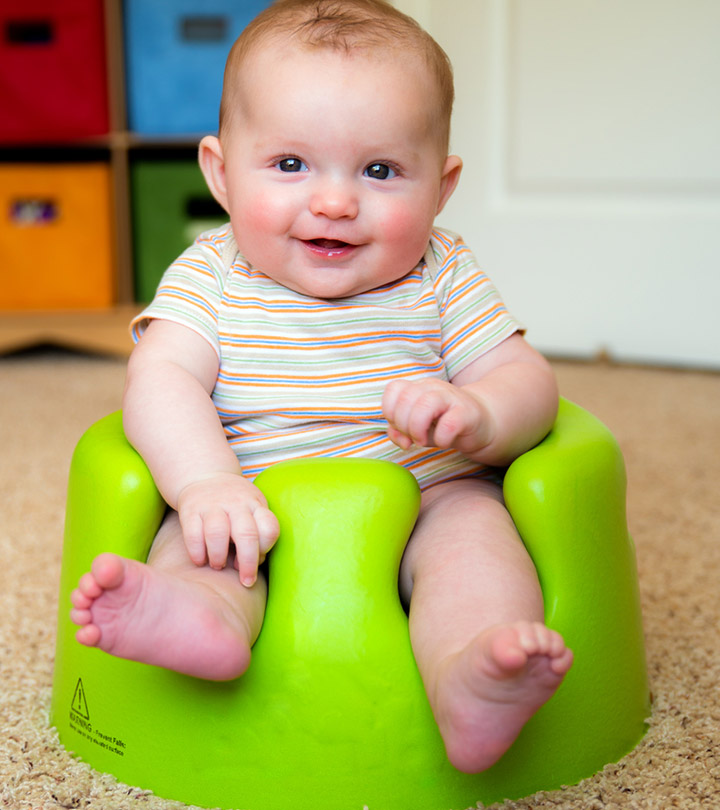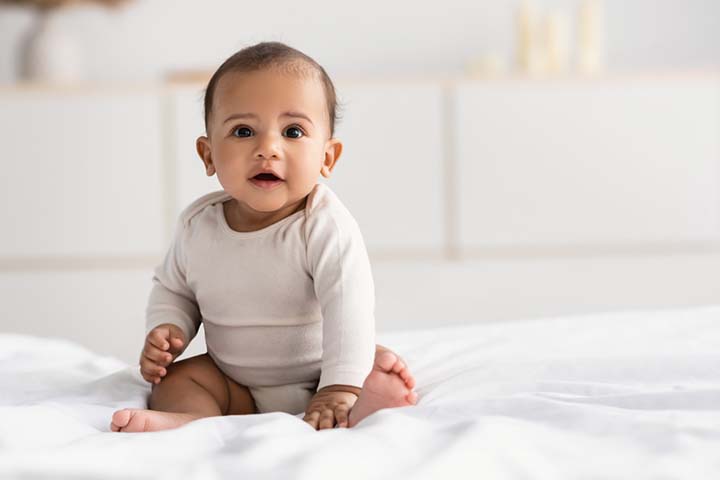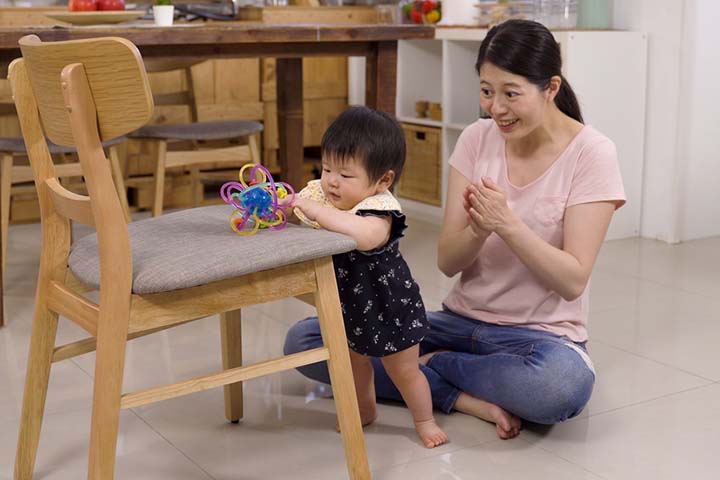Bumbo seats are a popular type of baby seat that parents may consider for their little one. But when can babies start sitting in a Bumbo seat? You need to understand Bumbo seats first. Bumbo seat is a brand of seats known for their unique shape that may help a baby sit without any support. It has a carved-out and snug seat with an armrest, backrest, and a stopper at the front. Some variants feature a seatbelt to keep the baby secure.
Read this post to know the uses and potential safety concerns associated with Bumbo seats for babies.
When Can A Baby Sit In A Bumbo Seat?
Most babies can usually sit without support by the age of six months (1). However, babies can get into a sitting position by themselves between the ages of eight and twelve months (2).Therefore, you may use a Bumbo seat for your baby only after they show readiness to sit by themselves. It indicates that the baby’s muscles are strong enough to hold the head and back steady without support.
Are Bumbo Seats Safe For Babies?
Bumbo seats are considered safe and appropriate when used as intended, that is, placed on the floor and used under adult supervision (3). The seats allow parents to place the baby in a seated posture, so they may interact or play with those around. Bumbo seats may be useful when camping or traveling with your baby since they are lightweight. You can place the baby in the seat for feeding or to keep them entertained.
Natalie Bennett, a mother of three, shares her experience using a Bumbo seat for her children. She explains, “I enjoyed having my babies in a Bumbo seat when I want to just quickly prop them up for something. I have seen their ability to sit and look around and be upright. It improved after having them in the Bumbo, only a short time during the day. I never leave them in this for long periods as I know that it can affect their hip health, and so I don’t want to be, you know, harming them in that way (i).”
Do Bumbo Seats Help Babies Sit Up?
There is limited research on whether seats, such as Bumbo seats, can help babies sit up. A study noted that babies younger than eight months could sit well without any problems when provided postural support, such as with a Bumbo seat (4). However, the study did not further explore if the seat could teach the baby to sit independently or expedite the achievement of the ability to sit independently.
Most babies can usually sit independently, even on toddler chairs, between the ages of eight and eighteen months (5). Therefore, it is best to wait for the baby to develop the innate motor skills to sit up by themselves. It is usually safer since the ability to sit independently indicates stronger muscles, which can be better at stabilizing the body and avoiding falls when seated.
What Are The Precautions For Using A Bumbo Seat?
You must keep the following points in mind when using a Bumbo seat for your baby.
- Never leave your baby unattended while in a Bumbo seat, even for a few moments.
- Do not put the seat on an elevated surface as it increases the risk of falling.
- Purchase Bumbo seats that feature a safety lap belt. If the Bumbo seat does not have a lap belt, the baby may crawl out of it and hurt themselves.
It should also be noted that if you use Bumbo seats or similar floor seats, baby chairs, car seats, or swings for an extended period, it might increase the risk of container baby syndrome (6). The syndrome occurs due to constant support provided by different equipment, such as seats, causing the baby to not use essential muscles to their full extent. It may ultimately cause the slow development of important muscles and delay the achievement of skills and milestones. Therefore, you may keep the use of a Bumbo seat limited to a few minutes each day.
What To Use Instead Of A Bumbo Seat?
The main aim of using a Bumbo seat is to assist and support a baby’s positioning while sitting up. Thus, instead of restraining them to a container seat and restricting their movements, you may try various other activities. These activities could help exercise the baby’s muscles and achieve developmental milestones, such as the ability to sit up (7) (8).
- Encourage tummy time since it is one of the best activities to help strengthen your baby’s muscles and promote progression to achieving developmental milestones. Tummy time can be started as early as after birth.
- Try supported seating with your baby. Babies can hold their heads steady and unsupported by four months (1). Place the baby in a sitting position on a soft surface on the floor. Sit behind them and support their back. You may place the baby in a few minutes each day until the age of six months, when the baby can sit by themselves without support.
- Introduce activities that help develop gross motor skills, including reaching out to objects and pushing and pulling objects while seated. It may help strengthen back muscles, making it easier for the baby to stabilize their body while seated.
Bumbo seats are convenient and help your babies to sit by providing the necessary back support. However, if you are wondering, “when can babies start sitting in a Bumbo seat?” know that they can use it when they are strong enough to get into a seated position by themselves. Remember not to leave babies unattended in a Bumbo seat to avoid the risk of falling. Also, do not use these seats for an extended period as they may cause container baby syndrome. Instead of a Bumbo seat, you may use tummy time or other similar activities to strengthen your baby’s muscles and help them sit.
Key Pointers
- Babies usually start sitting up by six months of age, and it’s safe for them to sit on Bumbo seats placed on the floor under parental supervision.
- Ensure to pay attention to your baby when they are sitting on a Bumbo seat, don’t keep it at an elevated level, and purchase a seat with a lap belt.
- Some alternatives that can encourage sitting in babies are tummy time and introducing gross motor skills activities.
Learn how to use your Bumbo Floor Seat safely and correctly. Follow these step-by-step instructions for proper use and enjoy the comfort and convenience of your Bumbo Floor Seat.












